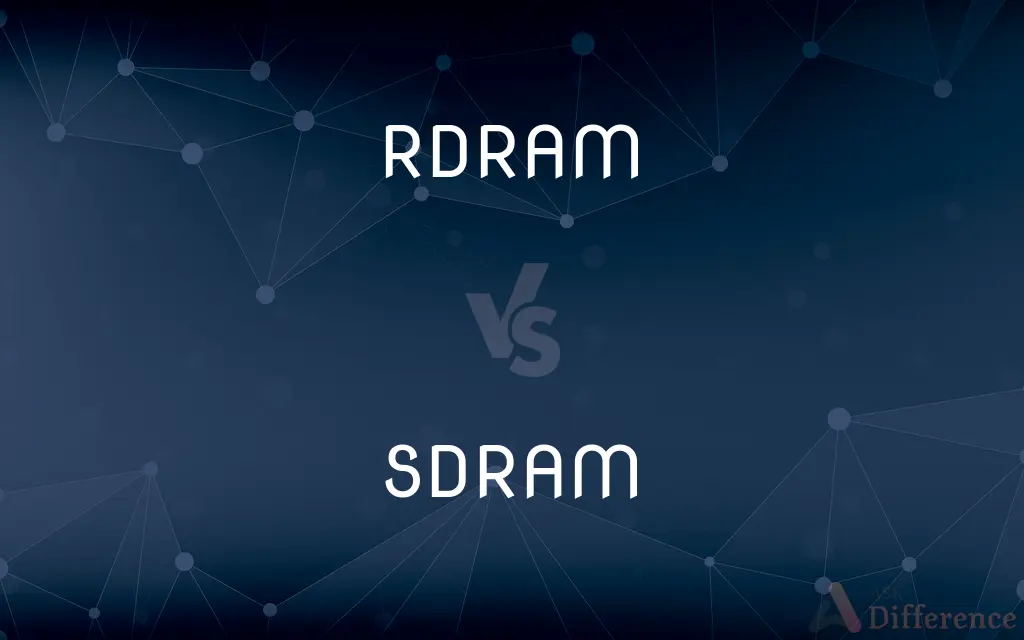RDRAM vs. SDRAM — What's the Difference?
By Tayyaba Rehman — Published on December 24, 2023
RDRAM is a type of RAM using Rambus technology, while SDRAM stands for Synchronous Dynamic Random-Access Memory. Both are memory types, but with different architectures and performances.

Difference Between RDRAM and SDRAM
Table of Contents
ADVERTISEMENT
Key Differences
RDRAM, which stands for Rambus Dynamic Random Access Memory, and SDRAM, standing for Synchronous Dynamic Random Access Memory, are both types of RAM used in computers. However, their underlying technologies and implementations differ significantly.
RDRAM, developed by Rambus Inc., was introduced during the late 1990s and was known for its high-speed data transfer. It operated in a narrow, high bandwidth channel, which was its unique selling proposition. However, SDRAM, which preceded it, worked by synchronizing itself with the computer's bus speed, ensuring a consistent performance.
While RDRAM was initially projected as the next-generation RAM due to its speed, it faced several issues. One of the primary criticisms of RDRAM was its cost. It was notably more expensive than SDRAM, making it less attractive for many users. SDRAM, on the other hand, was cheaper and provided reasonably good performance for its price.
The market eventually favored SDRAM and its successors, DDR (Double Data Rate) SDRAMs, due to their cost-effectiveness and overall better performance-to-price ratio. RDRAM, while having its unique features and advantages, couldn't sustain a competitive edge over SDRAM in the long run.
Comparison Chart
Full Form
Rambus Dynamic Random Access Memory
Synchronous Dynamic Random Access Memory
ADVERTISEMENT
Developer
Rambus Inc.
JEDEC
Speed
High-speed data transfer
Synchronized with computer's bus speed
Cost
More expensive
Generally cheaper
Market Acceptance
Less popular due to cost and compatibility issues
Widely accepted and used
Compare with Definitions
RDRAM
Memory that operates in a narrow, high bandwidth channel.
RDRAM was praised for its quick data transfer speeds.
SDRAM
A predecessor to DDR and DDR2 RAM.
SDRAM paved the way for the DDR era in computer memory.
RDRAM
Less common due to its cost and compatibility concerns.
While RDRAM was fast, it was often bypassed for cheaper alternatives.
SDRAM
Operates faster than traditional DRAM.
Upgrading from DRAM to SDRAM significantly improved performance.
RDRAM
A type of RAM developed by Rambus Inc.
The computer I bought in the early 2000s had RDRAM installed.
SDRAM
Uses a synchronous clock to streamline operations.
With its synchronized operations, SDRAM became a standard in memory technology.
RDRAM
A predecessor to the more modern DDR RAM.
Before DDR became standard, some systems used RDRAM.
SDRAM
Popular for its cost-effectiveness and performance.
For a balance between cost and speed, many chose SDRAM.
RDRAM
Known for its unique RIMM (Rambus Inline Memory Module) format.
Finding a RIMM for my old machine's RDRAM is a challenge.
SDRAM
A type of RAM that synchronizes with the computer's bus speed.
Most PCs in the late 90s came with SDRAM.
Common Curiosities
What is the full form of SDRAM?
SDRAM stands for Synchronous Dynamic Random Access Memory.
Why was RDRAM considered advanced?
RDRAM was known for its high-speed data transfer capabilities.
What does RDRAM stand for?
RDRAM stands for Rambus Dynamic Random Access Memory.
Which organization standardized SDRAM?
SDRAM was standardized by JEDEC.
Was SDRAM a predecessor or successor to DDR RAM?
SDRAM was a predecessor to DDR RAM.
What kind of module did RDRAM typically use?
RDRAM used a module called RIMM (Rambus Inline Memory Module).
Why did RDRAM become less popular over time?
RDRAM was more expensive and had compatibility issues, making it less popular.
Who developed RDRAM?
RDRAM was developed by Rambus Inc.
How does SDRAM synchronize its operations?
SDRAM synchronizes its operations with the computer's bus speed.
Which RAM type paved the way for DDR RAM?
SDRAM paved the way for DDR RAM.
Did RDRAM and SDRAM have different module formats?
Yes, RDRAM typically used RIMMs, while SDRAM used DIMMs.
Which RAM type was more common in the late 1990s and early 2000s?
SDRAM was more common during that period due to its cost and compatibility advantages.
Which type of RAM was more cost-effective: RDRAM or SDRAM?
SDRAM was generally more cost-effective than RDRAM.
Did RDRAM have a broader market acceptance than SDRAM?
No, SDRAM had broader market acceptance due to its cost-effectiveness and performance.
Is SDRAM faster than traditional DRAM?
Yes, SDRAM operates faster than traditional DRAM.
Share Your Discovery

Previous Comparison
NDM vs. FTP
Next Comparison
English Literature vs. Literature in EnglishAuthor Spotlight
Written by
Tayyaba RehmanTayyaba Rehman is a distinguished writer, currently serving as a primary contributor to askdifference.com. As a researcher in semantics and etymology, Tayyaba's passion for the complexity of languages and their distinctions has found a perfect home on the platform. Tayyaba delves into the intricacies of language, distinguishing between commonly confused words and phrases, thereby providing clarity for readers worldwide.
















































